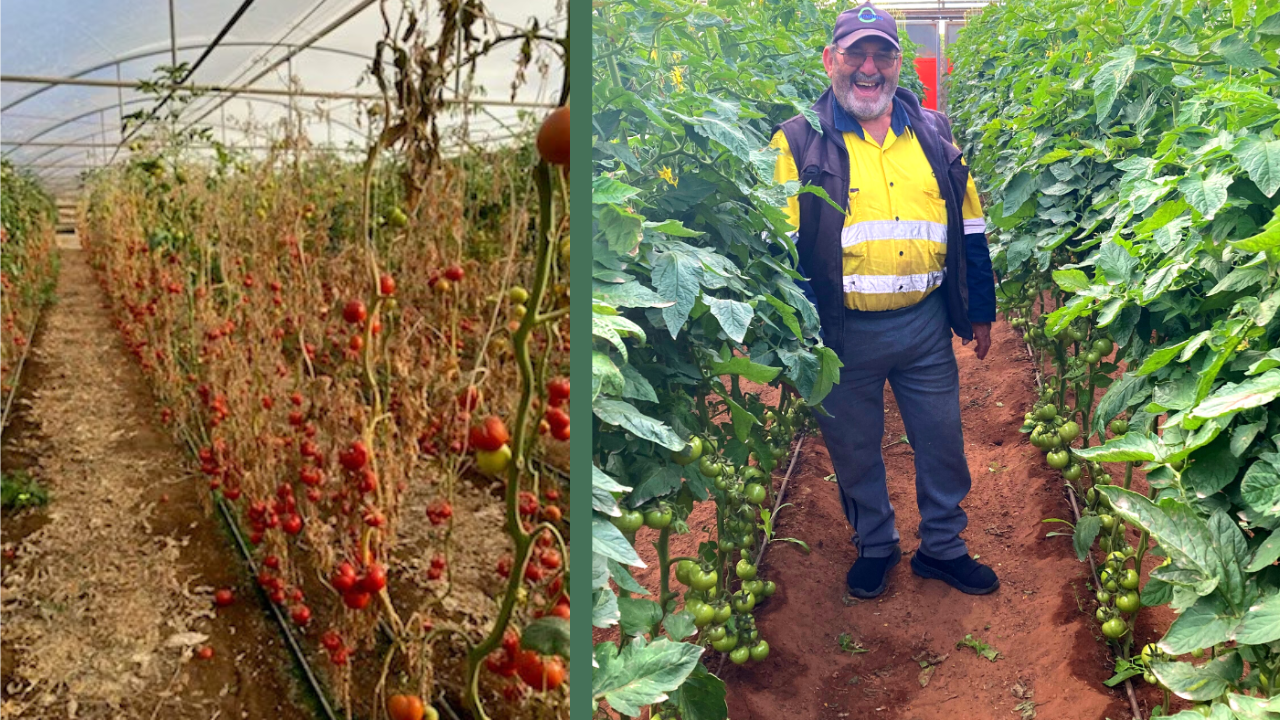GREENHOUSE TOMATO PRODUCTION

Grower Experience – Trentham Cliffs, NSW
The grower previously had total plant deaths of his tomato crop where it was found that Verticillium and Fusarium wilts had killed all of his plants when they reached the growth stage.
The grower decided to apply Strike fumigant to greenhouse soil on day 1 that had 4 rows of dripper tubes placed on the soil. Plastic was laid over the whole soil surface area that covered the dripper tubes. The fumigant was applied through the drippers and then flushed with clean water. Irrigation was applied on days 3 and 7 after fumigation for 20 minutes each session. On day 14 the plastic sheeting was removed and the soil was allowed to breathe. On day 15, the tomato seedlings were planted into the soil.
Now the plants are growing vigorously and with large numbers of flowers. The leaves are clean and large and the colour is a healthy dark green with no signs of any dieback. Tomato fruit grown on fumigated soil is uniform in size and colour, with no blemishes and shiny skins.
This grower had no signs of Verticillium and Fusarium pathogens in his soil and could potentially grow another tomato crop following this crop. For this to occur, all plant material from the previous crop would need to be removed from the soil and new seedlings planted.
Soil Fumigation
For successful tomato production, it is recommended that you use Strike products. In this case, the grower used Strike 60 Drip at a rate of 30g/m2 (300kg/ha)and when applied through the dripper irrigation tubes has been proven to show that both Verticillium and Fusarium wilts can be controlled. This same fumigant and rate has also been demonstrated to control both pathogens when applied as a shanked application in Western Australian tomato crops.
Diseases
Verticillium wilt is a soil-borne fungal disease of many vegetables that enters the plant through the roots. Infection with this fungus causes dieback and the leaves to wilt.
Fusarium wilt is a common vascular wilt fungal disease, exhibiting symptoms similar to Verticillium wilt. The pathogen that causes Fusarium wilt is Fusarium oxysporum
(F. oxysporum).
The wilt pathogens can be sporadic in their infection of individual plants and that infection is soil borne and must travel up the roots. Not all areas of soil have wilt pathogens and this allows some plants to escape unaffected but once the soil is disturbed and cultivated, wilt pathogen spores will be spread throughout the soil profile.
Process Involved in Application of Strike 60 Drip
1. In greenhouse soils make sure that the soil has been ripped and tilled, and all soil additives have been applied. Lay the dripper tubes in place in the row spacing required for the crop. Cover the dripper tubes with plastic (preferably black plastic) to the width of 50cm. Wet the soil up until it is moist but not flooded.
2. Apply Strike 60 Drip at 30g/m2 soil by injecting this into the irrigation mains that feed the dripper tubes. At the completion of injecting the Fumigant, flush the mains and dripper tubers for a period of 15 minutes.
3. Reapplying irrigation 3 days later for a period of 20 minutes and then repeat this step for another 4 days.
4. 14 days after the application date of Strike 60 Drip, cut the plastic holes at the sites of the tomato seedlings and allow 24 hours for the soil to breath and after this period plant the seedlings.
Note: Strike Products can only be purchased and applied by suitably accredited and licenced individuals. See your TriCal Australia Distributor.
To learn more about what soil fumigation can do in your fields contact us at 08 8347 3838 or info@trical.com.au

